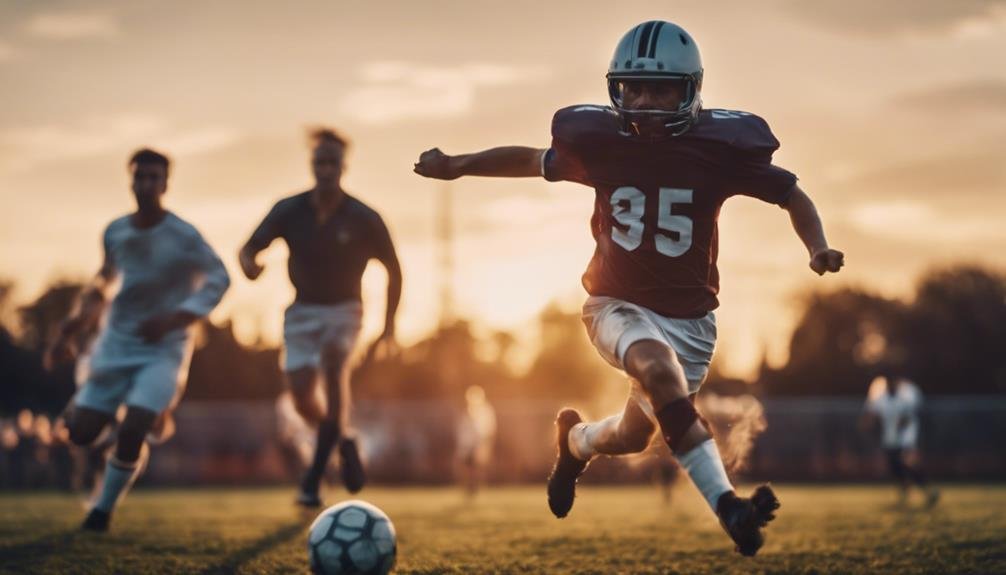Football might immediately come to mind when considering which sport has the most injuries due to its high-contact nature and the staggering number of injuries reported annually. But London concludes that other sports like basketball, soccer, and even cycling have alarming statistics. Each sport brings unique risks and injury types that could surprise you. Understanding these can help in developing better safety measures and training techniques. Are you curious about how these sports stack against each other regarding injury rates? Let’s pack details.
Key Takeaways
- Basketball had over 260,000 injury treatments in the U.S. in 2021, the highest among listed sports.
- Football accounted for more than 220,000 injury treatments in the U.S. in 2021.
- Soccer injuries led to over 140,000 treatments annually in the U.S.
- Rugby sees frequent injuries due to its physicality and frequent collisions.
- Hockey reported nearly 70,000 skating-related injury treatments annually.
Football Injuries

Football injuries are an important concern, especially for teens. In 2021, over 220,000 Americans were treated for related injuries. To minimize the risk, you should always wear all necessary safety equipment, including helmets, pads, and mouthguards. This gear is essential for protecting your body during the intense physical contact inherent in football.
A proper warm-up routine is necessary before you start playing. It helps prepare your muscles and joints, reducing the likelihood of strains and sprains. Stretching and light jogging can also significantly improve overall performance and injury prevention.
Limiting head contact during play is another crucial factor. Football injuries often involve concussions and other head traumas, so it’s important to follow guidelines that minimize head contact.
Learning and practicing proper tackling techniques can greatly reduce your risk of injury. Always keep your head up and use your shoulders to tackle, not your head.
Hydration is also important. Staying well-hydrated prevents cramps and other muscle-related issues during gameplay. Ensure you drink plenty of water before, during, and after practice or games.
Basketball Injuries
While football presents significant injury risks, basketball tops the list, with over 260,000 players treated for related injuries in the U.S. in 2021. Basketball injuries can range from minor sprains and strains to more serious injuries, making safety measures essential for every player.
You can minimize these risks by wearing proper equipment, such as eye protection, knee and elbow pads, a mouth guard, and an athletic supporter.
In addition to safety gear, in color warm-up routines are essential. These routines prepare your muscles and joints for the game’s physical demands, reducing the likelihood of sprains and strains.
Strength training also plays a crucial role in injury prevention. By building muscle strength, you enhance stability and support for your joints, making you less susceptible to injuries.
Do not underestimate the the importance of proper equipment. High-quality shoes with good ankle support can prevent common injuries, while other protective gear can shield you from more severe impacts.
Soccer Injuries

Soccer injuries are an important concern, contributing to over 140,000 treated cases annually in the U.S. As one of the most popular contact sports, soccer sees a high rate of injuries due to its physically demanding nature. Collision sports like soccer account for 80% of sports-related emergency visits for children aged 5 to 14. One of the most serious concerns involves traumatic brain injuries (TBIs), which make up approximately 22% of soccer injuries.
Proper heading techniques are vital to reducing the risk of injury. Without the right coaching, players are more susceptible to head injuries, including concussions. Emphasizing the importance of safety gear, such as shin guards and mouthguards, is necessary to minimize the risk of harm during play.
Due to the physical contact inherent in soccer, players often face a higher risk of injury, especially in collisions. It’s not the players who; referees and goalkeepers can find themselves in precarious situations. Understanding these risks and implementing appropriate safety measures can greatly reduce the number of injuries on the field, making soccer safer for everyone involved.
Rugby Injuries
Rugby injuries are alarmingly common due to the sposintensesicality and high-impact collisions. When you play rugby, youyyou’re exposeda high risk of injuries like concussions, which are all too frequent given the nature of the game. Head injuries can have serious long-term effects, so it’s important
to stay dislocated. ACL tears are other common injuries that rugby players face. These injuries often require immediate medical attention and a lengthy rehabilitation period. The physical demands of rugby make these injuries almost inevitable, highlighting the significance of proper training and conditioning.
Fractures, particularly in the collarbone, are also prevalent. RugRRugRugby’s inherentact and contact mean that bones are often at risk, adding another layer of danger to the sport. Lacerations from tackles and collisions are another issue, making protective gear essential for anyone stepping onto the field.
Despite the use of protective gear, the risk of injury remains high. Understanding these risks and taking appropriate measures to protect yourself is important.
Rugby is thrilling, but the potential for serious injuries cancan’t ignored.
Hockey Injuries

Have you ever considered how dangerous ice hockey can be, given the sposport’sgh speed and physical contact? Ice hockey presents a noteworthy injury risk, with nearly 70,000 skating injuries treated in emergency rooms annually. Among these, concussions are particularly widespread.
The sposport’sst-paced nature and frequent collisions make head contact common, raising the stakes for player safety.
To help mitigate these risks, it’it’ssential to adopt safety precautions:
- Wearing appropriate protective gear: Helmets, mouthguards, and padding are vital.
- Training on proper techniques: Learning to check safely and avoid dangerous plays reduces injury risk.
- Prompt reporting of injuries: Early identification and treatment of concussions and other injuries can prevent long-term issues.
- Emphasizing non-contact drills: Reducing head contact during practice helps protect players.
Player safety should always be a top priority. Encouraging immediate reporting of skating injuries ensures athletes receive the necessary care without delay.
While ice hockey is an exhilarating sport, it demands a commitment to safety precautions to keep players protected. Fostering a culture of safety and awareness can notably reduce the risk of serious injuries.
Gymnastics Injuries
In gymnastics, athletes face a high risk of injuries, with over 86,000 cases treated in emergency rooms each year. This sport, particularly prevalent in youth sports, sees a wide array of injuries due to its demanding nature. Common gymnastics injuries include sprains, strains, fractures, and dislocations, often resulting from the intense physical demands and the complexity of the routines.
As you progress in gymnastics, the risk of injury increases, especially with advanced skills and intricate maneuvers. A sprain might occur when you land awkwardly, while strains often result from overstretching during a routine. Fractures and dislocations can happen when a fall or misstep exerts excessive force on your bones and joints.
Proper coaching is vital to mitigate these risks. Quality instruction ensures youyou’rearning techniques correctly, reducing the likelihood of injury. Regular equipment maintenance is equally important, as faulty gear can contribute to accidents. Additionally, gradual skill progression helps your body adapt to the increasing demands, significantly lowering the risk of serious injuries.
Rock Climbing Injuries

While gymnastics poses significant injury risks, rock climbing has the highest injury rate among all sports. As one of the most difficult sports, rock climbing exposes you to severe injuries, including fractures, sprains, and concussions.
Rock climbing injuries often result from various factors, the most alarming of which is malfunctioning gear. Imagine scaling a steep cliff only to have your harness fail—such scenarios can lead to catastrophic consequences.
Additionally, the very nature of rock climbing involves frequent impacts with hard surfaces, increasing the likelihood of ankle fractures and head injuries like concussions.
To keep yourself safe, it’it’ssential to be aware of the most common injuries and how to prevent them:
- Fractures: Often occur from falls or impacts with rocks.
- Sprains: Usually affect the wrists and ankles due to sudden twists and turns.
- Concussions: Result from head impacts during falls or collisions with rock surfaces.
- Malfunctioning Gear: Faulty ropes, harnesses, and carabiners can lead to severe accidents.
Baseball Injuries
Following proper safety protocols and using appropriate protective gear can greatly reduce baseball injuries. In 2021, over 116,000 emergency room visits were due to injuries from baseball and softball. To lower these numbers, it would be best if you prioritized player safety through several key measures.
First, wearing helmets and guards is essential. These safety equipment protect important areas like the head, shins, and elbows, greatly decreasing the risk of severe injuries.
Warm-up routines are another essential aspect of injury prevention. Stretching and getting your heart rate up before playing can help prepare your muscles and joints for the gamgame’sysical demands. Incorporating detachable bases can also reduce the likelihood of injuries during slides and quick direction changes.
Practicing proper safety precautions extends beyond just the players; coaches and officials should enforce these measures to ensure a safe playing environment. By focusing on player safety and consistently using the right safety equipment, you can enjoy the game while minimizing your risk of injury.
Whether youyou’reaying baseball or softball, these steps will help keep you out of the emergency room and on the field where you belong.
Cycling Injuries

Just like in baseball, prioritizing safety can greatly reduce injuries in cycling. Cycling injuries are a serious concern, especially for children aged 5-14, who account for over 200,000 injury treatments annually. These injuries often result from falls, collisions, or accidents on the road. Bicycle accidents can lead to severe head injuries, making helmets essential to any cyccyclist’sar.
To better understand the common causes of cycling injuries, consider the following:
- Falls: Losing control or hitting an obstacle often results in falls.
- Collisions: Crashing into other cyclists, pedestrians, or vehicles can cause significant harm.
- Accidents on the road: Poor road conditions and driver negligence are major contributors.
- Lack of helmets: Not wearing a helmet increases the risk of head injuries.
Ensuring road safety and educating young cyclists about the importance of helmets can reduce the incidence of injuries. Keep your bike well-maintained, and always be vigilant about your surroundings.
Injury Prevention Tips
Use proper protective gear and maintain good physical conditioning to minimize sports injuries. When playing basketball, wearing protective gear like knee pads, elbow pads, and mouth guards is essential. These items can greatly reduce the risk of common basketball injuries, such as bruises, cuts, and dental damage.
Injury prevention also involves incorporating regular strength training into your workout routine. Building muscle strength helps stabilize joints and improves overall body mechanics, making you less prone to injuries. Additionally, always start with warm-up routines before hitting the court. Activities like dynamic stretches and light jogging increase blood flow to your muscles, reducing the likelihood of strains and sprains.
Perfecting your techniques is another important aspect of injury prevention. Proper shooting, dribbling, and landing techniques can help you avoid awkward movements that often lead to injuries.
Lastly, dondon’tderestimate the importance of good conditioning. Maintaining a high level of fitness improves your performance and ensures that your body is better equipped to handle the physical demands of the sport.
Conclusion
Injuries are unfortunate in many sports, with football leading the pack due to its high-contact nature. However, basketball, soccer, rugby, hockey, rock climbing, baseball, and cycling pose significant risks.
You must prioritize injury prevention through proper training, using appropriate gear, and following safety measures. By taking these steps, youyou’lllp minimize your chances of getting hurt and enjoy a healthier, more rewarding sports experience.
FAQs
What sport has the highest rate of injuries?
American football is often cited as the sport with the highest injury rate, particularly in the United States. Due to the high-impact nature of the game, players are at risk for a wide range of injuries, including concussions, ligament tears, fractures, and sprains. The combination of physical contact, speed, and the aggressive nature of the sport contributes to its high injury rate.
Key Points:
- High Impact: Frequent physical contact and collisions.
- Common Injuries: Concussions, ligament tears, fractures, and sprains.
What other sports are known for high injury rates?
In addition to American football, other sports with high injury rates include basketball, soccer, and rugby. Basketball players frequently suffer from ankle sprains, knee injuries, and fractures. Soccer players are prone to injuries like sprains, strains, and concussions due to the sposport’sst pace and physical contact. Rugby, similar to football, has a high rate of concussions and musculoskeletal injuries due to the intense physical nature of the game.
Other Sports with High Injury Rates:
- Basketball: Ankle sprains, knee injuries, fractures.
- Soccer: Sprains, strains, concussions.
- Rugby: Concussions, musculoskeletal injuries.
What factors contribute to the high injury rates in these sports?
Several factors contribute to the high injury rates in sports like football, basketball, and soccer. These include the level of physical contact, the speed at which the game is played, and the physical demands placed on the athletes. Additionally, improper training, inadequate protective equipment, and lack of conditioning can increase the risk of injury. Preventative measures, such as proper training, conditioning, and wearing appropriate gear, are essential to reducing injury risks.
Contributing Factors:
- Physical Contact: Increases the likelihood of injuries.
- Game Speed: A faster pace leads to higher injury potential.
- Preventative Measures: Proper training and equipment are crucial.

